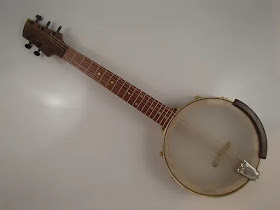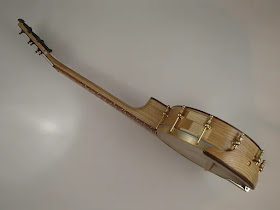Last summer my goal was to familiarize myself with the local Irish tune repertoire so that I could play along at sessions. For the most part, I have met that goal. Starting now, my goal is to take that one step farther and be able to actually start (lead?) sets at the session and play a set of three tunes all the way through without stopping. The mistake I made over the last year, if you can call it that, was to spend most of my practice time playing along with recordings rather than trying to recall the tune from memory. As a result, I "know" dozens of tunes well enough that I can join in at the session if hear them being played, but left to my own devices there are several murky sections that remain in these tunes. Here's now I plan to fix that.
View sets as one entire piece of music. Practice the transitions between tunes. Don't waste time practicing what you've already learned well, but focus on the tunes, or sections of tunes, within a set that still need work. Ultimately being able to play the entire set from memory without stopping.
Struggle to recall before looking at the music. I don't think looking at the sheet music for an Irish tune is such a bad thing, especially if you're stuck on one section that you can't figure out by ear. What I don't like though is being completely dependent on the notation or using it as a crux. To help deplete that even further, I have started doing something that I didn't do at all last year and that is just play a tune without having the audio or notation handy. If it's a tune that I'm already quite familiar with the sound of, struggling to find and re-find those notes on your instrument can be a good thing. Practice completely from memory. Don't constantly check the music.
If/when looking at the music, try and make note of things for the purpose of not having to look next time. Get your eyes off the sheet music as soon as possible and limit your return looks. When looking at the music, try to recognize something memorable about every single measure if possible. Notice things like the structure of the tune, patterns within the music, scalar runs, arpeggiated sections, familiar note sequences that show up in a lot of tunes, and repeated measures or sections. Take note of quirky things about the tune, like a section starting from a note that is not part of the tonal center chord. When recalling the tune later, bring to mind these things you noticed about it in the first place.
Record yourself playing a tune slowly and cleanly. After you learn a tune, record yourself playing a good version of it and then upload that recording to an app like the Amazing Slow Downer. Create a playlist of these recordings. Use the app to speed up the recording so that you can "hear" yourself playing cleanly at speeds faster than your current ability. Then visualize making that increased speed a reality. This will teach your brain to process faster speeds and possibly trick your brain into believing you can play this fast. If it helps you to look at the music or tab while making this recording that is fine, but put the tab away as soon as you make the recording and use the audio sound as your "visual" source.
Practice playing from anywhere in the tune. Don't always start a tune at the beginning. Maybe start at the end and work your way backwards. Give equal time to all parts of the tune. Learn the B-part as well as the A-part. If one part of the tune is weaker than another, focus on that weaker area until it is your strongest part of the tune. Focus on areas of weakness until they become areas of strength.
Practice improv and variations. Can you play the tune differently each time through? Can you play each measure a little differently each time through? How far can you purposefully vary from the melody (while still hearing the melody in your head) and still get back on track? Not only is this great preparation for "owning" the tune, but it's also a lot of fun!
Visualize yourself playing through the tune while away from your instrument. "Hear" the melody in your mind as you imagine yourself playing. This allows the brain to build associations between the sounds you imagine in your head and the movement of your hands. Could you write out the tune for someone completely from memory with no instrument handy? Can you recite all the notes of the tune?
Practice Spaced Repetition. Revisit a tune right before you're going to forget it. This means that even when you're learning a tune you don't have to play it every single day. Take a three day break and see if you still remember it. Take a 7 day break and see if you remember it. If you can't remember it after 7 days go back to every 3 days. If you can remember it after 7, go to 14 days between playing it.
Divide practice time. Don't just sit there and play one tune for 30 minutes. Play it for a few minutes then switch to something else for five minutes. Then go back to the tune you were playing before. And so on. Break it up into little mini chunks.
Create flash cards and group them into categories. In my case, I spent the last two days writing the names of all the sets that get played at the TrailJams session onto little notecards. One set per card. This gets back to my first item above, which is to view a set of three tunes as one piece of music. I am now going to break these sets into one of five different categories: 1) sets I don't know at all (none of the three tunes are familiar yet), 2) sets where I know 1 of the 3 tunes, 3) sets where I know 2 of the 3 tunes, 4) sets where I can fake my way through playing all three tunes but maybe not at speed and/or not without hearing the music, and 5) fully memorized sets that I can play through from memory at speed with or without a backing track or drum beat. Obviously sets I don't know at all or where I can only play 1 of the tunes need the most attention, whereas sets that I am close to being able to play all the way through at speed just need a little periodic polishing or refreshing.
Years ago, before sheet music was handy and before there were audio recordings, you had to use your own memory, imagination and creativity to recall a tune and make it your own. Maybe simulating that inconvenience can lead to being able to play more tunes from memory!
That should do it. This list is mostly for my benefit in case I get stuck!































